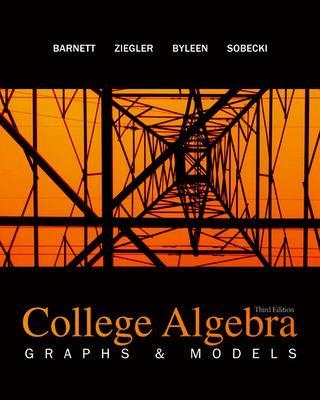
College Algebra: Graphs and Models
McGraw-Hill Inc.,US (Verlag)
9780077221287 (ISBN)
- Titel ist leider vergriffen;
keine Neuauflage - Artikel merken
I was born and raised in Cleveland, and started college at Bowling Green State University in 1984 majoring in creative writing. Eleven years later, I walked across the graduation stage to receive a PhD in math, a strange journey indeed. After two years at Franklin and Marshall College in Pennsylvania, I came home to Ohio, accepting a tenure-track job at the Hamilton campus of Miami University. I’ve won a number of teaching awards in my career, and while maintaining an active teaching schedule, I now spend an inordinate amount of time writing textbooks and course materials. I’ve written or co-authored either seven or twelve textbooks, depending on how you count them, as well as several solutions manuals and interactive CD-ROMS. After many years as developmental math coordinator at Miami Hamilton, I share the frustration that goes along with low pass rates in the developmental math curriculum. Far too many students end up on the classic Jetson’s-style treadmill, with the abstract nature of the traditional algebra curriculum keeping them from reaching their goals. Like so many instructors across the country, I believe the time is right to move beyond the one-size-fits-all curriculum that treats students the same whether they hope to be an engineer or a pastry chef. “Because we’ve always done it that way” is NOT a good reason to maintain the status quo in our curriculum. Let’s work together to devise alternate pathways that help students to learn more and learn better while hastening their trip into credit-bearing math courses. Since my book (Math in Our World) is written for the Liberal Arts Math and Quantitative Literacy market, I think I’m in the right place at the right time to make a difference in the new and exciting pathways course. I’m in a very happy place right now: my love of teaching meshes perfectly with my childhood dream of writing. (Don’t tell my publisher this – they think I spend 20 hours a day working on textbooks – but I’m working on my first novel in the limited spare time that I have.) I’m also a former coordinator of Ohio Project NExT, as I believe very strongly in helping young college instructors focus on high-quality teaching as a primary career goal. I live in Fairfield, Ohio with my lovely wife Cat and fuzzy dogs Macleod and Tessa. When not teaching or writing, my passions include Ohio State football, Cleveland Indians baseball, heavy metal music, travel, golf, and home improvement.
CHAPTER 1 FUNCTIONS, GRAPHS, AND MODELS1-1 Using Graphing Utilities1-2 Functions1-3 Functions: Graphs and Properties1-4 Functions: Graphs and Transformations1-5 Operations on Functions; Composition1-6 Inverse FunctionsChapter 1 ReviewChapter 1 Group Activity: Mathematical Modeling–Choosing a Long Distance Calling PlanCHAPTER 2 MODELING WITH LINEAR AND QUADRATIC FUNCTIONS2-1 Linear Functions2-2 Linear Equations and Models2-3 Quadratic Functions2-4 Complex Numbers2-5 Quadratic Equations and Models2-6 Additional Equation Solving Techniques2-7 Solving InequalitiesChapter 2 ReviewChapter 2 Group Activity: Mathematical Modeling in Population StudiesCumulative Review Exercise for Chapters 1 and 2CHAPTER 3 POLYNOMIAL AND RATIONAL FUNCTIONS3-1 Polynomial Functions And Models3-2 Polynomial Division3-3 Real Zeros and Polynomial Inequalities3-4 Complex Zeros and Rational Zeros of Polynomials3-5 Rational Functions and Inequalities3-6 Variation and ModelingChapter 3 ReviewChapter 3 Group Activity: Interpolating PolynomialsCHAPTER 4 MODELING WITH EXPONENTIAL AND LOGARITHMIC FUNCTIONS4-1 Exponential Functions4-2 Exponential Models4-3 Logarithmic Functions4-4 Logarithmic Models4-5 Exponential and Logarithmic EquationsChapter 4 ReviewChapter 4 Group Activity: Comparing Regression ModelsCumulative Review Exercise for Chapters 3 and 4CHAPTER 5 MODELING WITH SYSTEMS OF EQUATIONS AND INEQUALITIES5-1 Systems of Linear Equations in Two Variables5-2 Systems of Linear Equations in Three Variables5-3 Systems of Linear Inequalities5-4 Linear ProgrammingChapter 5 ReviewChapter 5 Group Activity: Modeling with Systems of EquationsCHAPTER 6 MATRICES AND DETERMINANTS6-1 Matrix Solutions to Linear Systems6-2 Matrix Operations6-3 Inverse of a Square Matrix6-4 Matrix Equations and Systems of Linear Equations6-5 Determinants6-6 Properties of Determinants6-7 Determinants and Cramer's RuleChapter 6 ReviewChapter 6 Group Activity: Using Matrices to Find Cost, Revenue, and ProfitCumulative Review Exercise for Chapters 5 and 6CHAPTER 7 SEQUENCES, INDUCTION, PROBABILITY7-1 Sequences and Series7-2 Mathematical Induction7-3 Arithmetic and Geometric Sequences7-4 Multiplication Principle, Permutations, and Combinations7-5 Sample Spaces and Probability7-6 Binomial FormulaChapter 7 ReviewChapter 7 Group Activity: Sequences Specified by Recursion Formulas8 ADDITIONAL TOPICS IN ANALYTIC GEOMETRY8-1 Conic Sections; Parabola8-2 Ellipse8-3 Hyperbola8-4 Systems of Nonlinear EquationsChapter 8 ReviewChapter 8 Group Activity: Focal ChordsCumulative Review Exercise for Chapters 7 and 8Appendix A BASIC ALGEBRA REVIEWA-1 Algebra and Real NumbersA-2 ExponentsA-3 RadicalsA-4 Polynomials: Basic OperationsA-5 Polynomials: FactoringA-6 Rational Expressions: Basic OperationsAppendix A ReviewAppendix A Group Activity: Rational Number RepresentationsAppendix B REVIEW OF EQUATIONS AND GRAPHINGB-1 Linear Equations and InequalitiesB-2 Cartesian Coordinate SystemB-3 Basic Formulas in Analytic GeometryAppendix C SPECIAL TOPICSC-1 Significant DigitsC-2 Partial FractionsC-3 Descartes' Rule of SignsC-4 Parametric EquationsAppendix D GEOMETRIC FORMULAS
| Verlagsort | New York |
|---|---|
| Sprache | englisch |
| Maße | 211 x 259 mm |
| Gewicht | 1896 g |
| Themenwelt | Mathematik / Informatik ► Mathematik ► Algebra |
| ISBN-13 | 9780077221287 / 9780077221287 |
| Zustand | Neuware |
| Informationen gemäß Produktsicherheitsverordnung (GPSR) | |
| Haben Sie eine Frage zum Produkt? |
aus dem Bereich


